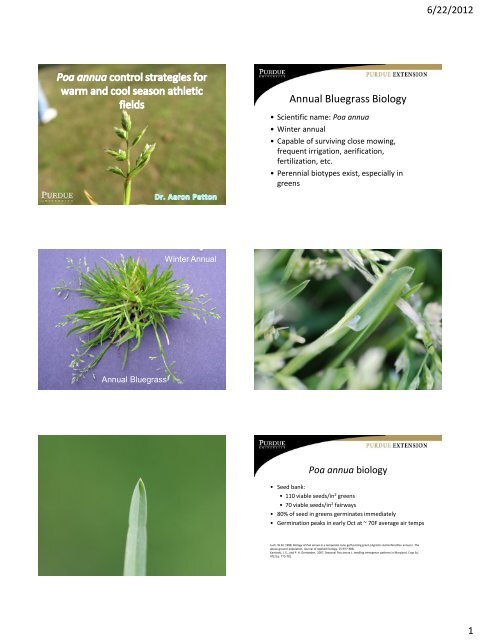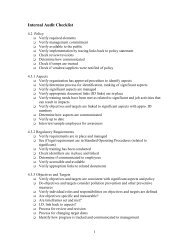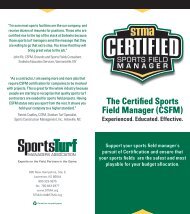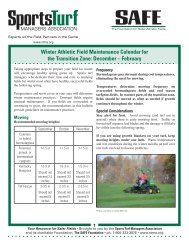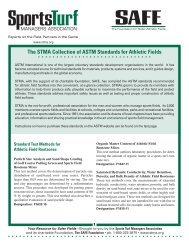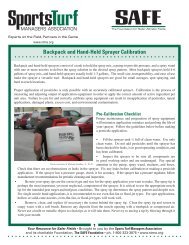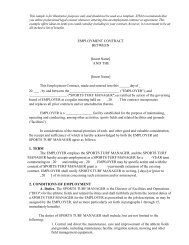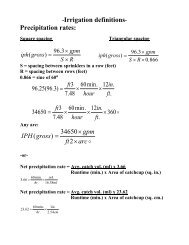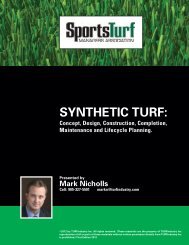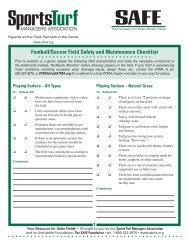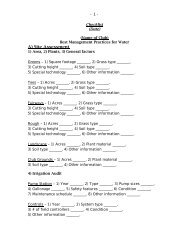Poa annua control strategies for warm and cool season ... - STMA
Poa annua control strategies for warm and cool season ... - STMA
Poa annua control strategies for warm and cool season ... - STMA
Create successful ePaper yourself
Turn your PDF publications into a flip-book with our unique Google optimized e-Paper software.
6/22/2012Annual bluegrassBiology• <strong>Poa</strong> <strong>annua</strong>germinates in latesummer to early fallat soil temperaturesaround 70 F.• A second germinationflush may occur inmid- to late-winterCultural Control Strategies• Prevention/ExclusionCultural Control Strategies• Irrigation• N rate• N timing• Aerification timing2
6/22/2012Herbicides will cause youproblems if you intend toestablish (seed, spring, sod) turfin the future. Know therestrictions be<strong>for</strong>e you proceed!<strong>Poa</strong> <strong>annua</strong> <strong>control</strong> in<strong>cool</strong>-<strong>season</strong> turf?Annual bluegrass <strong>control</strong> in <strong>cool</strong><strong>season</strong>turf• Options <strong>for</strong> <strong>control</strong>– Ethofumesate (Prograss)• Two sequential fall applications spaced three to four weeksapart. A spring application of Prograss may also improve<strong>control</strong> when applied following fall applications. CertainKentucky bluegrass cultivars may be injured by Prograss whenapplied at 0.5 gallon/acre as indicated on the label.– Tenacity (mesotrione)– Xonerate (amicarbazone)– Velocity ( bispyrabac-sodium) – Sod <strong>and</strong> Golf onlyTenacity- Golf <strong>and</strong> Sod Labeled UsesPrograss (ethofumesate)• Most effective when applied in fall as twosequential applications spaced three tofour weeks apart.• Rate varies by species:– Kentucky bluegrass rate is 0.5 gallon/acre– Tall fescue rate is 0.5-1.0 gallon/acre– Perennial ryegrass rate is 0.66-1.33 gallon/acre• Inconsistent <strong>control</strong>• Bleacher• PRE <strong>and</strong> POST broadcastapplications (5-8 fl oz/A)• Repeat POST applications at 2-3 weeks• + NIS• New seedings:(except finefescues) 5-8 fl oz/A• Prior to or post-seeding• Avoid newly germinatedseedlings• 16 fl oz/A per year max• (0.50 lbs ai/A) maximumTurf SpeciesK. bluegrassTall fescueP. ryegrassFine fescueRate5-8 fl oz/A(0.156-0.25 lb ai/A)5 fl oz/A(0.156 lb ai/A)3
6/22/2012$113/A $85/A $57/A $218/AAnnual bluegrass <strong>control</strong>• Three applications of Tenacity at 5 oz/A in the fallwould be the best <strong>control</strong> strategy.• Starting Tenacity applications in mid-September,end of September, or mid October all workedequally well.• These results were obtained under the conditionsof our experiment. Results will vary by location.4
6/22/2012Annual Bluegrass in JanuaryWhat about <strong>Poa</strong> <strong>annua</strong> <strong>control</strong> inbermudagrass?untreatedtreatedAnnual bluegrass can be competitive as well as unattractive<strong>Poa</strong> <strong>control</strong> in nonoverseedbermudagrass• New chemistry• Old chemistry• Also known as …….Two approachesAnnual Bluegrass ControlHerbicide Rate TimingRoundup 16 oz Dormant (January)Simazine 1 lb DecemberAtrazine 1 lb DecemberWaiting until March or April to <strong>control</strong> <strong>annua</strong>l bluegrass is abad idea. Once it is well-tillered <strong>control</strong> with products suchas simazine declines. Other problems with late <strong>control</strong>includes failure to remove competition <strong>for</strong> the emerging<strong>warm</strong> <strong>season</strong> grass <strong>and</strong> the appearance of the <strong>annua</strong>lbluegrass carcasses in the turf.6
6/22/2012Annual Bluegrass• Roundup is a cheap, effective herbicide indormant bermudagrass.• Roundup does not provide anypreemergence <strong>control</strong>.• It is possible to have a second flush of<strong>annua</strong>l bluegrass if Roundup is used.• Tank mixing a preemergence herbicide withRoundup prevents this problem.Annual Bluegrass• Simazine or atrazine at 1.0 quart/acreapplied in November-December.• Repeat in February if needed.Princep 1 lb ai /AAAtrex 1 lb ai / ARoundup Pro 0.5 lb ai/ATreated Dec 22, 2003 Photo Feb 5, 2004Annual Bluegrass Herbicides• Sulfonylurea herbicides <strong>for</strong> <strong>annua</strong>l bluegrass• Monument - trifloxysulfuron• Revolver - <strong>for</strong>amsulfuron• Tranxit – rimsulfuron• Katana – flazasulfuron• Certainty - sulfosulfuron• Postemergence <strong>control</strong> <strong>and</strong> some preemergence <strong>control</strong>.• Good safety at any time on bermudagrass.Annual bluegrass <strong>control</strong>Certainty (left side)Monument (right side)Applied Nov 30, 2004 Photo Feb 24, 2005Monument 0.33 oz/ac applied 10-17-06, Photo 2-6-077
6/22/2012Monument 0.33 oz/ac; applied 1-21-04; photo 3-10-04Monument + Barricade applied 10-17-06, Photo 2-6-07TranXit 2.0 oz/ac; applied 1-21-04; photo 3-10-04Untreated, Photo 2-6-07Revolver 8.8 fl oz/ac; applied 1-21-04; photo 3-10-04Annual bluegrass carcasses from late application.8
6/22/2012Sulfonylurea HerbicidesSlide courtesyJim Brosnan,University ofTennesseeRevolver (8.8 to 17.4 fl oz/A)Monument (0.35 to 0.53 oz/A)Katana (3 fl oz/A)TranXit (1 to 2 oz/A)Certainty (1.25 to 2.0 oz/A)Soil temperatures > 60 F2% increase in <strong>control</strong> per degreeEnhanced activity with N fertilizationSlide courtesy Jim Brosnan, University of TennesseeField Results• Annual bluegrass <strong>control</strong> greater with N fertility‣ 73, 59, 35 % increases <strong>for</strong> 0.25, 0.50, <strong>and</strong> 1.5 oz rates‣ Ammonium sulfateWhat about <strong>Poa</strong> <strong>annua</strong> <strong>control</strong> inoverseeded bermudagrass?• Control with 0.25 oz + N > 1.5 oz alone‣ 11 out of 12 dates across two yearsBarricade at 0.75 lb/ai a, applied10 weeks be<strong>for</strong>e overseeding<strong>Poa</strong> <strong>annua</strong> in overseeded ryegrassBarricade 0.5 lb/ai a, applied 10weeks be<strong>for</strong>e overseeding9
6/22/2012Safe to apply 1-2 weeks after theperennial ryegrass emergenceWhat about using PGRs?Will that work?Slide courtesy Jim Brosnan, University of TennesseePGRs• Paclobutrazol (Trimmit)• Flurprimidol (Cutless)• Flurprimidol + trinexapac-ethyl (Legacy)• All three (Muskateer)• Data on putting greens suggest thesereduce <strong>annua</strong>l bluegrass sometimes.PGRs continued• Regulates <strong>annua</strong>l bluegrass more thancreeping bentgrass allowing creepingbentgrass to fill in thin areas• Won’t likely work on athletic fields– Different species– Different cutting heights– Annual biotypes vs. perennial biotypesWhat new experimentalproducts are coming?Methiozolin (MRC-01)• Moghu Research Center in South Korea• Registered in South Korea in 2010 <strong>and</strong> widely used• Good safety on CB, TF, PR, KBG• Good activity on <strong>Poa</strong> <strong>annua</strong> <strong>and</strong> P. trivialis• PRE <strong>and</strong> POST activity – unsure how exactly it works?• Current research at many locations• Available in USA in 2015? Cost?10
Annual bluegrass (%)6/22/2012Research Objective - FWY• Determine the efficacy of MRC-01 <strong>for</strong><strong>annua</strong>l bluegrass <strong>control</strong> in a mixedcreeping bentgrass/<strong>annua</strong>l bluegrassfairway as influenced by rate <strong>and</strong>application timing.Methods• Treatments (9):– MRC-01 treatments (4):• October 1 + November 1 @ 1.0 kg/ha at each application• October 1 + November 1 @ 2.0 kg/ha at each application• April 1 + May 1 @ 1.0 kg/ha at each application• April 1 + May 1 @ 2.0 kg/ha at each application– Velocity treatments (2)• October 1 + November 1 @ 6 oz/A at each application• April 1 + May 1 @ 6 oz/A at each application– Xonerate treatments (2)• October 1 + October 15 @ 2 oz/A at each application• April 1 + April 15 @ 2 oz/A at each application– Untreated <strong>control</strong>Annual bluegrass cover – 5/2540353025AAAAAAConclusions2015B1050BBTreatmentThings to keep-in-mind withYOUR <strong>annua</strong>l bluegrass program• Different biotypes from location to location– What works <strong>for</strong> you might not work <strong>for</strong> yourneighbor• Seasonal changes in ABG populations arenatural– You need an untreated check% <strong>Poa</strong> cover rated visually. Treatment means are averaged over 7 treatments.11
6/22/2012Where did it go?• No matter which herbicide you will use<strong>Poa</strong> <strong>annua</strong> cover drops dramaticallyover the summer• If no untreated area is included onyour fields, you will likely deduce thatyour strategy is working even if it isn’tThings to keep-in-mind withYOUR <strong>annua</strong>l bluegrass program• Stay ahead• Hardest to <strong>control</strong> weed on planet?Things that will survey after nuclear holocaustThings that will survey after nuclear holocaustwww.agry.purdue.edu/turfhttp://purdueturftips.blogspot.com/12
6/22/2012A New Purdue Weed Control Publication:Turfgrass Weed Control <strong>for</strong> ProfessionalsDr. Aaron Patton <strong>and</strong>Dan WeisenbergerQuick help <strong>for</strong> selectingherbicides <strong>for</strong> <strong>control</strong>ling specificweedsAvailable July 17, 201288 pp. | 8.5 x 11$12.00Questions?• Aaron Patton• ajpatton@purdue.edu• (765) 494-973713


